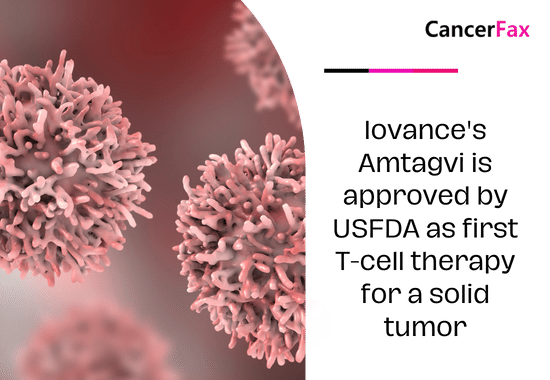Iovance’s Amtagvi is approved by USFDA as first T-cell therapy for a solid tumor
Iovance Biotherapeutics’ first-of-its-kind immunotherapy was approved by the FDA. This means that T-cell therapy, which has changed the way some types of blood cancer are treated, can now be used directly on solid tumors.
The drug is the first personalized tumor-infiltrating lymphocyte (TIL) treatment to hit the market. It is called Amtagvi or lifileucel. The FDA sped up the approval process on Friday for people with advanced melanoma who have already been treated with a PD-1 inhibitor or a BRAF inhibitor if the tumor has the BRAF V600 gene.
The list price of the drug is a little higher than the prices for current CAR-T cell therapies, which for people with blood cancer cost about $500,000 or less. That’s because Iovance thought Amtagvi was worth a lot as the first drug approved for this type of melanoma after PD-1, and they also looked at other drugs that were similar, Vogt said.
Like other CAR-T cell treatments, Amtagvi is made from immune cells that have been taken from specific patients. TIL cells from a patient’s removed tumor are used to make the final product. These cells are then grown outside of the body and then injected back into the patient.
The immune system makes TIL cells on its own, which can find unique markers on the surface of cancer cells and fight them. Amtagvi simply gives the body more of these immune cells that fight cancer because the body’s own immune cells lose their effectiveness over time.
Before Amtagvi, CAR-T treatments could only fight some types of blood cancer. This is because solid tumors don’t have the right cell-surface biomarkers for CAR-T cells to target. That problem can be solved by TIL treatment, since TIL cells are naturally set up to find biomarkers of cancer.
In one-arm study, Amtagvi at the now-recommended dose range shrunk tumors in 31.5% of 73 patients who had already been treated with an anti-PD-1 drug. 43.5% of those who responded had been in remission for more than a year after 18.6 months of follow-up.
The objective response rate was the same at 31.4% in a supporting pooled efficacy study that looked at 153 patients. Also, 56.3% of respondents still had answers after a year. A new update to the pooled analysis showed that patients lived an average of 13.9 months, and nearly half of them were still alive after four years. This information is not included in the current label.
Even though Amtagvi is a big step forward, it’s not perfect.
First, because Amtagvi is made from TIL cells from a patient’s own tumor, it won’t work for people who can’t have surgery or who don’t have enough tumor tissue removed.
Second, the drug comes with a boxed warning about deaths linked to treatment, severe cytopenia that lasts for a long time, severe infections, and heart, lung, and kidney damage. This means that the drug can only be bought at certain treatment centers inside of hospitals where people are staying. The FDA-approved label for the drug also says that patients must be monitored for side effects in an intensive care unit and have access to experts.
Vogt still said that Amtagvi’s boxed warning is better than what is happening with current CAR-Ts. As an example, Amtagvi is not controlled by a safety program required by the FDA. This program is called risk review and mitigation strategies. Also, the drug doesn’t have any warnings about cytokine release syndrome or hemophagocytic lymphohistiocytosis, two side effects of CAR-T cell treatments that can be very dangerous and even kill.
Vogt said that the boxed warning was expected and that doctors already know what the medicine is like.
Jim Ziegler, Iovance’s marketing chief, said on the call that the company is on track to have more than 50 centers in about 100 days. Thirty centers have already been set up and are ready to treat patients when the drug goes on sale.
There have been availability problems with a number of CAR-T therapies, especially during the launch phase. “We have sufficient capacity as we’re onboarding these sites in a controlled, disciplined way,” Ziegler said of the Amtagvi launch. The Philadelphia facility where the company works and a nearby contract manufacturer can eventually serve “several thousand patients annually,” Vogt said.
WuXi STA, a unit of WuXi AppTec, said in a statement on Tuesday that its plant in Philadelphia has been given permission by the FDA to test and make Amtagvi.
The process of making amtagvi can take a long time. For now, Iovance thinks that the average time it takes to make a product—from when a tumor gets to the factory to when the finished product is released—will be 34 days. Don’t forget the time it takes to ship.
Some people might have trouble with the long wait time. The drug’s pooled effectiveness study originally looked at 189 patients, but 33 didn’t get the drug because of things like eight patients not getting the product or their disease getting worse or dying.
Also, patients have to go through a lot of complicated treatments before and after receiving Amtagvi. This is done to either get the body ready for the injection or to make the cells healthier or to deal with side effects. Also, patients must stay within two hours of the treatment center for “several weeks” to watch for side effects. These steps will cost more money and make things harder for patients.
Payers have said they like the value offer for Amtagvi, even though it costs a lot, Ziegler said. From what Iovance has talked to payers about so far, the company thinks it will get coverage similar to current CAR-T therapies, with a need for prior permission, he said.
The FDA has approved Amtagvi through a faster review process. Iovance is also running a phase 3 study with the code name TILVANCE-301 to make sure the drug works in the real world. The study compares Amtagvi with Keytruda, a PD-1 inhibitor from Merck & Co., versus Keytruda by itself in people with melanoma who have not been treated yet.
It was a long and difficult path to get Amtagvi’s icon cleared. Iovance had planned to file in 2020, but had to change their plans when the FDA raised concerns about the tests they used to see how effective each therapy amount was. With the help of the test, the company was able to get its application approved by the FDA quickly in May 2023. But the FDA then stretched its review because the agency didn’t have enough resources.
During the delays, Vogt temporarily took over as CEO from Maria Fardis, Ph.D., who had been in charge before. A stable captain has not been chosen.
Iovance is also working on a TIL treatment called LN-145, which is being tested in phase 2 for non-small cell lung cancer after PD-1. Iovance said last year that the important IOV-LUN-202 trial could also speed up the clearance process.
Amtagvi is produced by utilizing immune cells from each patient, much as current CAR-T cell treatments. The final product is created by harvesting a patient’s TIL cells from a section of their surgically removed tumor, expanding them outside, and then reintroducing them into the patient’s body.
The immune system produces TIL cells that can identify certain markers on cancer cells and initiate an immune response. Amtagvi replenishes the body with cancer-fighting immune cells as the naturally produced cells weaken with age.
Prior to Amtagvi, CAR-T therapies were limited to addressing certain blood cancers due to the absence of suitable cell-surface indicators in solid tumors for CAR-T cells to target. TIL therapy addresses the issue by utilizing TIL cells that are inherently programmed to recognize cancer biomarkers.
Amtagvi, administered at the approved dosage range in a single-arm study, resulted in tumor reduction in 31.5% of 73 patients who had prior exposure to anti-PD-1 treatment. After 18.6 months, 43.5% of participants who responded to the treatment had remained in remission for over a year.
An examination pooling data from 153 patients showed a comparable objective response rate of 31.4%. Additionally, 56.3% of participants sustained long-lasting effects after one year. A recent update of the pooled data revealed that patients had a median survival of 13.9 months, with almost half of the patients still surviving after four years, despite not being mentioned on the current label.
Amtagvi, although innovative, is not flawless.
Due to the utilization of TIL cells from a patient’s tumor, individuals who are unable to have surgery or do not have sufficient resected tumor tissues are not eligible for Amtagvi therapy.
The medicine has a boxed warning for treatment-related fatalities, sustained severe cytopenia, severe infection, and cardiac and kidney damage. The medicine is exclusively available at specific treatment centers within an inpatient hospital environment. The drug’s FDA-approved label mandates patients to be monitored for side effects in an intensive care unit and requires specialists to be present.
Vogt contended that Amtagvi’s boxed warning is an improvement compared to the current scenario with existing CAR-Ts. Amtagvi is not regulated under the FDA-mandated safety program called risk evaluation and mitigation measures. The medicine does not have warnings for cytokine release syndrome or hemophagocytic lymphohistiocytosis, which are serious consequences of CAR-T cell therapy.
Vogt stated that the boxed warning was anticipated and that physicians are already familiar with the medicine’s properties.
Iovance has enlisted 30 designated facilities prepared to treat patients upon the drug’s release, with plans to increase to over 50 centers within about 100 days, as stated by Iovance’s commercial chief, Jim Ziegler.
Multiple CAR-T therapies have faced supply shortages, particularly during the first rollout. Ziegler stated that there is enough capacity for the Amtagvi launch since they are gradually adding these sites in a regulated and methodical manner. Vogt stated that the company’s own facility in Philadelphia and a neighboring contract manufacturer had the capacity to eventually treat several thousand patients annually.
On Tuesday, WuXi STA, a subsidiary of WuXi AppTec, announced that its Philadelphia facility has been approved by the FDA to conduct analytical testing and production of Amtagvi.
Amtagvi might have a lengthy manufacturing process. Iovance anticipates that the average manufacturing process duration, from tumor arrival at the manufacturing facility to final product release, will be 34 days. Excluding the time for shipment.
Prolonged waiting times may pose an issue for certain patients. The medicine’s combined effectiveness analysis initially had 189 patients, however 33 did not receive the drug due to causes such as product manufacturing failure for eight patients and disease progression or death for 11 patients.
Patients receive intricate treatments before and after Amtagvi administration to either prime the body for infusion, enhance cell viability, or manage side effects. Patients must remain within a two-hour radius of the treatment center for “several weeks” to check adverse effects. These procedures will result in additional expenses and physical hardships for patients.
Ziegler stated that payers have acknowledged the value proposition of Amtagvi despite its high cost. Iovance anticipates securing coverage comparable to existing CAR-T therapies, with a prior authorization need, based on its conversations with payers.
Amtagvi has been approved by the FDA using the fast approval procedure. Iovance is now completing a phase 3 trial named TILVANCE-301 to validate the drug’s therapeutic efficacy. The trial is comparing the combination of Amtagvi with Merck & Co.’s PD-1 inhibitor Keytruda to using Keytruda alone in untreated melanoma patients.
Amtagvi’s approval process was arduous and challenging. Iovance had planned to submit a file in 2020 but postponed it due to FDA inquiries over the assays used to measure the potency of each therapeutic dose. In May 2023, the company successfully passed the assay hurdle and had its application accepted by the FDA for priority review. The FDA extended its review due to resource constraints at the agency.
Vogt assumed the role of interim CEO in 2021, replacing prior CEO Maria Fardis, Ph.D., during the delays. No permanent helmsman has been appointed.
Iovance is developing a TIL therapy called LN-145, which is undergoing phase 2 clinical trials for post-PD-1 non-small cell lung cancer, in addition to Amtagvi. Last year, Iovance stated that the crucial IOV-LUN-202 trial might lead to an expedited approval.
Dr. Nishant Mittal is a highly accomplished researcher with over 13 years of experience in the fields of cardiovascular biology and cancer research. His career is marked by significant contributions to stem cell biology, developmental biology, and innovative research techniques.
Research Highlights
Dr. Mittal's research has focused on several key areas:
1) Cardiovascular Development and Regeneration: He studied coronary vessel development and regeneration using zebrafish models1.
2) Cancer Biology: At Dartmouth College, he developed zebrafish models for studying tumor heterogeneity and clonal evolution in pancreatic cancer.
3) Developmental Biology: His doctoral work at Keio University involved identifying and characterizing medaka fish mutants with cardiovascular defects.
4) Stem Cell Research: He investigated the effects of folic acid on mouse embryonic stem cells and worked on cryopreservation techniques for hematopoietic stem cells.
Publications and Presentations
Dr. Mittal has authored several peer-reviewed publications in reputable journals such as Scientific Reports, Cardiovascular Research, and Disease Models & Mechanisms1. He has also presented his research at numerous international conferences, including the Stanford-Weill Cornell Cardiovascular Research Symposium and the Weinstein Cardiovascular Development Conference.
In summary, Dr. Nishant Mittal is a dedicated and accomplished researcher with a strong track record in cardiovascular and cancer biology, demonstrating expertise in various model systems and a commitment to advancing scientific knowledge through innovative research approaches.
- Comments Closed
- March 5th, 2024






Advanced melanoma immunotherapy, AMTAGVI approval, FDA-approved cell therapy 2024, First TIL therapy, Iovance Biotherapeutics innovation, Lifileucel for melanoma, Solid tumor breakthrough, Tumor-Infiltrating Lymphocyte treatment
CancerFax is the most trusted online platform dedicated to connecting individuals facing advanced-stage cancer with groundbreaking cell therapies.
Send your medical reports and get a free analysis.
🌟 Join us in the fight against cancer! 🌟
Привет,
CancerFax — это самая надежная онлайн-платформа, призванная предоставить людям, столкнувшимся с раком на поздних стадиях, доступ к революционным клеточным методам лечения.
Отправьте свои медицинские заключения и получите бесплатный анализ.
🌟 Присоединяйтесь к нам в борьбе с раком! 🌟